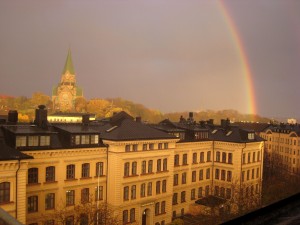Are Creative Countries Happier? More Competitive?

Good place to be creative.
Is it possible to measure a country’s creativity? If so, how does creativity relate to other national characteristics like prosperity, sustainable growth, and happiness?
And, is it time to think less about creative companies and more about creative cities? Perhaps instead of giving tax breaks to attract companies, creative cities should charge a fee to companies that want to capitalize on their creative citizens. But then, how do you create a creative city?
Creativity is joining the traditional trio of land, labor, and capital as one of the key drivers of productivity and growth. In the traditional industrial world, we could use standard measures of land, labor, and capital to identify competitive advantages and disadvantages. But what about creativity? How do we measure countries (and cities) on their creative potential? And how do we develop a competitive advantage in creativity?
These are some of the basic questions the 2015 edition of the Global Creativity Index (GCI). The Martin Prosperity Institute* (MPI) created the index and first published it in 2004, with an expanded version arriving in 2011. (Click here). This year’s index, published over the summer, is the most comprehensive yet.
Can you really measure a country’s or a city’s creativity? MPI argues that there are three elements of creativity and that we already have multiple indexes for each of them. Conveniently, each element begins with a T.
Technology – countries that produce innovative technologies are probably more creative than those that don’t. The GCI uses existing indexes of R&D investment and patent activity to measure the Technology component of creativity.
Talent — the war for talent is certainly raging in creative circles. Old school companies – like Accenture – are buying up design firms – like Fjord – to focus their creative talents on business issues. But how do you measure the creative talent in a country? The GCI uses educational and occupational indexes to identify the creative class.
Tolerance – we know that diversity counts in innovation. Getting different people with different ideas to “collide” is a fundamental innovation strategy. Diversity requires tolerance of other people and of ideas that were not invented here. How to measure tolerance? The GCI uses two proxies: “openness to ethnic and religious minorities and openness to gay and lesbian people”.
MPI researchers create an index for each of the three Ts and then roll them altogether to create one Global Creativity Index. In this year’s ranking, Australia comes in first – it’s the most creative country in the world. Following Australia (in order) are the USA, New Zealand, Canada, Denmark, Finland, Sweden, Iceland, Singapore, the Netherlands.
Does this list sound familiar? It’s quite similar to the list of the happiest countries in the world. (Click here and here). The Nordic countries dominate the happiness rankings. Similarly, Australia, New Zealand, Canada, and the Netherlands are always near the top of happiness indexes.
So, does happiness cause creativity or vice-versa? Are we just measuring the same thing in different ways? Let’s talk about it more in upcoming articles. In the meantime, I hope that you’re both happy and creative.
*MPI is headed by Roger Martin and located at the Rotman School of Management at the University of Toronto. Long-time readers of this website will remember that I’ve written about both Martin and Rotman several times. Martin encouraged Rotman to adopt design thinking as a core element of the curriculum. I’ve also referenced Martin’s efforts to bring critical thinking to business schools. He also advised A.G. Lafley of P&G on strategy. Interesting thinker; interesting school.
Was Leonardo Da Vinci Innovative?

Let’s tweak it, Leo.
We all know that Leonardo Da Vinci was a genius. But was he innovative?
The question draws a distinction between invention and innovation and between creativity and construction. As Wikipedia puts it, “[Da Vinci] conceptualized a helicopter, a tank, concentrated solar power, an adding machine, and the double hull, also outlining a rudimentary theory of plate tectonics. Relatively few of his designs were constructed or were even feasible during his lifetime….”
In other words, Leonardo had great ideas but many of them were never implemented. So, were they innovations?
That leads to another question: why did Britain lead the way in the Industrial Revolution? Other countries – notably France, Germany, Italy, and Sweden – had great universities and well established scientists and laboratories. Why did Britain create the industrial surge while others followed?
That’s the question that Ralf Meisenzahl and Joel Mokyr address in their working paper published by the National Bureau of Economic Research. Their short answer: Britain didn’t have more geniuses than other countries, but it did have more tweakers and implementers.
Meisenzahl and Mokyr argue that Britain certainly had its fair share of “hall-of-fame” inventors. But many of those genius ideas would not have been turned into practical innovations if not for “…a group of skilled workmen who possessed the training and natural dexterity to … carry out the ‘instructions’ contained in the … blueprints, … build the parts … with very low degrees of tolerance, and … fill in the blanks when the instructions were inevitably incomplete.”
Meisenzahl and Mokyr try to distinguish between tweakers and implementers. Tweakers “…improved and debugged an existing invention.” Implementers were “…skilled workmen capable of building, installing, operating and maintaining, new and complex equipment.”
Meisenzahl and Mokyr identified 758 men and one woman (Elenor Coade “who invented a new process for making artificial stone…”) whom they could classify as tweakers or implementers. Each person in the database was born between 1660 and 1830. Meisenzahl and Mokyr studied the industries they worked in, what they did, how they were incented, and how they acquired their skills. Among their key findings:
- The apprenticeship system was critical – it produced not only knowledge but also the skill to produce finely tuned machines. It also provided talented youngsters with a stable environment while they acquired and honed their skills.
- Multiple incentives were available. Much has been made of the British patent system in spurring innovation. But the authors argue that a system of prizes was equally or more important. Organizations such as the Society of Arts offered prizes for the development of specific devices, such as a machine to manufacture lace. Many such prizes were awarded “on the condition … that no patent was taken out” – which allowed the innovation to spread more rapidly.
- A “mechanical culture” – the authors point out that, “The second half of the eighteenth century witnessed the maturing of the Baconian program, which postulated that useful knowledge was the key to social improvement. In that culture, technological progress could thrive.”
So Britain not only had its fair share of geniuses but also had a well organized cadre of people who could tweak, improve, and implement the ideas the geniuses handed on. Just think what Leonardo might have done.